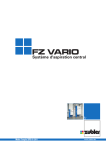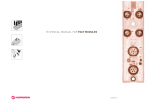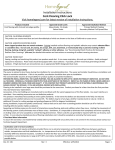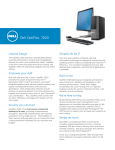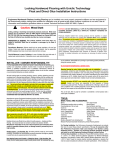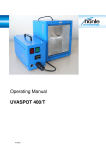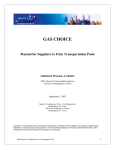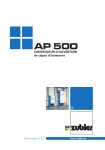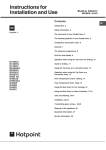Download Operating Instructions
Transcript
Operating Instructions en/us Operating Instructions SPS 07-2007 www.zubler.de 1 Contents 0. Introduction 0.1 Declaration of Conformity Page 3 1. Suction Machines 1.1 Design 1.2 Method of operation: 1.3 Technical Data: 1.4 Scope of Supply Page 4 2. Filter Systems 2.1 Technical Design 2.2 Method of Operation 2.3 Technical Data: 2.4 Scope of Supply Page 7 3. Putting the Suction Machine into Operation 3.1 Connecting Up the Suction Machine 3.2 Switching On the Suction Machine Page 9 Page 10 4. Functional Description and Adjustment 4.1 Filter Material 4.2 Dedusting System 4.3 Maximum Mode for Laboratory Cleaning and Pipework Maintenance 4.4 Open-loop and Closed-loop Control System 4.5 Changing the Settings of the Extraction System 4.5.1 Changing the Rate of Suction 4.5.2 Changing the Holding Time for Maximum 5. Operation of the Automatic Suction Unit Opener 5.1 Suction Unit Valve 5.2 Automatic Switch AP500 5.2.1 Connection 5.2.2 Setting the Level of Sensitivity 5.2.3 Setting the Run-on Time 5.2.4 Loading Factory Settings (Reset) Page 12 6. Dust Sockets Page 16 7. Maintenance of the Central Extraction System 7.1 Emptying the Dust Container 7.2 Emptying the Sand Separator S1 7.3 Emptying the Sand Separator S1 7.4 Changing the Dust Filter Cartridge 7.5 Maintenance on the Main Piping System 7.6 Maintenance Chart for the Central Extraction System Page 16 8. Troubleshooting Page 21 9. Spare Parts Page 22 Page 22 10. Service and Maintenance by the Manufacturer Page 2 Zubler Gerätebau GmbH ■ Buchbrunnenweg 26 ■ D-89081 Ulm ■ Fon +49(0)731-14 52 -0 Fax +49(0)731-14 52 13 0. Introduction Dear Customer, We are pleased that you have decided in favour of a Zubler central extraction system and do hope you enjoy using it. Ongoing development of our technology is based on collaboration with experienced dental technicians. The focus is on our aim to make extraction equipment quieter and more user-friendly. Excellent performance and cost-effectiveness are essential. To ensure smooth operation you should read the operating instructions carefully. This extraction system is solely designed for dry dust. These operating instructions do not include a detailed description of installation. It is assumed that the extraction system has already been installed in your laboratory by the technical staff and that the suction units have been connected up. No liability claims will be accepted on the basis of the illustrations or technical information. We reserve the right to make modifications, without updating these instructions. 0.1 Declaration of Conformity We, Zubler Gerätebau GmbH Buchbrunnenweg 26 89081 Ulm Jungingen declare that the product, central dust extraction system complies with the protection requirements of the following directives: 89/336/EEC EMC Directive 73/23/EEC Low - voltage Directive 93/68/EEC CE Marking 89/392/EEC Machinery Directive This declaration becomes invalid if there is any modification to the product which is not agreed with us. Kurt Zubler Managing Director Page Zubler Gerätebau GmbH ■ Buchbrunnenweg 26 ■ D-89081 Ulm ■ Fon +49(0)731-14 52 -0 Fax +49(0)731-14 52 13 3 1. Suction Machines 1.1. Design 6 8.2 8.1 8 27 7 28 29 26 33 5 37 3 9 4 25 24 31 23 10 2 30 13 Fig. 1: Left: Front view of FZ5/2 Centre: Internal components of the FZ5/2 extraction system Right: Left view of FZ5/2 without side cover (4) Legend 2 380V / 16A socket 23 Star grip nut 3 Compressed-air nozzle 24 Filter cartridge 4 Side cover 25 Filter dedusting system 5 ON/OFF master switch 26 Blower 6 Cooling air port for motor 27 Motor 7 Motor housing 28 Access to motor and cable terminal 8 Button for maximum suction 29 Air outlet (left) 8.1 Dust box control/Reset button 30 Housing for electronic control 8.2 Malfunktion control/Reset button 31 Intake port (left) 9 Filter housing 36 38 39 34 12 11 14 35 33 Frequency inverter 10 Dust socket 34 Compressed-air cylinder 11 Lever 35 Compressed-air hose for filter dedusting 12 Dust container 36 Filter dedusting valve 13 Base plate 37 EASY control relay 14 Vacuum hose for dirt container 38 Safety valve 15 Dirt pan cover 39 Pressure-reducing valve 22 Dirt pan Page 4 Zubler Gerätebau GmbH ■ Buchbrunnenweg 26 ■ D-89081 Ulm ■ Fon +49(0)731-14 52 -0 Fax +49(0)731-14 52 13 6 8.2 8.1 8 7 29 33 5 9 37 31 3 4 10 3 15 2 30 14 22 12 11 13 Fig. 2: Left: Front and rear view of FZ10 Centre: Internal components of the FZ10 extraction system Right: Left view of FZ10 without side cover (4) Fig. 3: Left: Front and rear view of FZ20 Centre: Internal components of the FZ20 extraction system Right: Left view of FZ20 without side cover (4) Page Zubler Gerätebau GmbH ■ Buchbrunnenweg 26 ■ D-89081 Ulm ■ Fon +49(0)731-14 52 -0 Fax +49(0)731-14 52 13 5 1.2. Method of operation: The dust produced at source in the laboratory passes into the central extraction system through the piping connected to the intake port (31). The dust is separated off in the dust filter cartridge (24). The dust filter cartridge is attached to the inside of the filter housing (9). The filtered air passes via the blower (26), which is located in the motor housing (7), into the exit air pipe connected to the air outlet (29). The air is discharged into the open air via a noise damper. 1.3. Technical Data: Type of extraction system: FZ5/2 FZ10 Width 760 mm 720 mm Height 1620 mm 2100 mm Depth 600 mm 590 mm Weight 165 kg 200 kg Voltage EU 380-480 V ± 10% 3-phase US 200-230V ± 10% 3-phase (single phase optional) Power input (max.) 9.2 kVA Frequency 50-60 Hz ± 2 Hz Air flow (max.) 27 m2/min Vacuum (max.) 8000 Pa Motor frequency 0-100 Hz Filter quality*Dust class "M" (DIN EN 60335-2-69) Filter area 5m2 10m2 Compressed-air supply5- 8 bar oil and water-free Capacity of pressure vessel 10l 14l 14l Capacity of dust container FZ20 1100 mm 2100 mm 600 mm 230 kg 20m2 40l * The filtered air from the central dust extraction systems must not be returned to the laboratory rooms. The separation capacity indicated by dust class "M" of the main filter only serves as information concerning the quality of exit air discharged into the open air. 1.4. Scope of Supply: Central extraction system 380V / 16A connecting cable Exit air noise damper 5 m compressed-air hose 5 dust bags 1 telephony noise damper 1,000 mm x 200 mm Page 6 Zubler Gerätebau GmbH ■ Buchbrunnenweg 26 ■ D-89081 Ulm ■ Fon +49(0)731-14 52 -0 Fax +49(0)731-14 52 13 2. Filter Systems 2.1. Technical Design 68 69 68 69 9 9 4 10 10 4 11 12 11 12 13 Fig. 4: Left: Filter system EF5 Right: Filter system EF10 13 4 9 10 11 12 13 15 68 69 Side cover Filter housing Dust socket Lever Dust container Base plate Dirt pan cover Extraction nozzle Cover 2.2. Method of Operation Some of the laboratory work spaces are connected to this filter unit via a separate piping system. A connection is made to the suction machine via extraction nozzle 68. Owing to this so-called dual-circuit system it is possible to segregate types of dust. The EF 5 filter systems can be used either for pure dirt or for mixtures of dust containing precious metals. The aim is to reduce separation costs by disposing of the main bulk of laboratory dirt directly and ensuring that dust containing precious metals has a higher level of concentration. Page Zubler Gerätebau GmbH ■ Buchbrunnenweg 26 ■ D-89081 Ulm ■ Fon +49(0)731-14 52 -0 Fax +49(0)731-14 52 13 7 2.3.Technical Data: Type of filter system Width Height Depth Weight Voltage Power input (max.) Filter quality*Dust class "M" (DIN EN 60335-2-69) Filter area Compressed-air supply5- 8 bar oil and water-free Capacity of pressure vessel Capacity of dust container EF5 760 mm 1220 mm 600 mm 110 kg EF10 720 mm 1620 mm 600 mm 120 kg 24V 10 W 5m2 10m2 10l 14l 40l * The filtered air from the central dust extraction systems must not be returned to the laboratory rooms.put The separation capacity indicated by dust class "M" of the main filter only serves as information concerning the quality of exit air discharged into the open air. 2.4. Scope of Supply: Filter system EF10 5 m compressed-air hose 5 dust bags Page 8 Zubler Gerätebau GmbH ■ Buchbrunnenweg 26 ■ D-89081 Ulm ■ Fon +49(0)731-14 52 -0 Fax +49(0)731-14 52 13 3. Operation Important: The seal (sealing lip) of the dust filter cartridge is compressed the first time it is screwed tight. On account of "settling" the pressure exerted decreases after a few days. Therefore, 4 weeks after putting into operation or changing the filter check the star grip nut (see section 7.4 on page 19) to make sure it is firmly in place, and tighten up if necessary. 3.1 Connecting Up the Suction Machine Installation of the machine and connection to the piping system are normally performed by specialised fitters when the extraction system is installed. Connect the extraction pipes coming from the laboratory to the intake nozzles, item 31 (on the left and right). Connect the exit air piping system to the nozzle, item 29. Use the flexible 380 V, 16A connecting cable enclosed in order to make the electrical connections between the extraction system and your building power supply. Plug the coupling with plug (2) on the extraction side and the cable connector into the socket of the 380V building power supply. Press the connection nipple (18) with the compressed-air hose (17) into the couling 17 18 19 20 (20) of the compressed air network (21) (5-8 bar). When disconnecting, hold the connection nipple tightly and retract the locking mechanism (19) in the direction of the arrow. The system must not be operated without being connected to the compressed air supply or else the dust filter cartridge cannot be subjected to automatic compressed-air dedusting. To prevent the filter cartridge from becoming clogged, the compressed air from your compressed air system must be oil and water-free. Modern cold air dryers meet the requirements for industrial compressed air in accordance with ISO 8573.1 21 17 18 19 20 21 3.2 Switching On the Suction Machine Put the Central Extraction System into operation by turning on at the ON/OFF power switch (5). Beforehand check to make sure there is a supply of compressed air in the extraction system and in the laboratory. If the compressor system is only started up at the same time as the suction machine, the suction units in the laboratory will be open because the network is not pressurised. In addition, make sure the dust container is positioned correctly and the lever (11) is in a vertical position. Only then is the extraction system sealed tight. Before switching on, please also check to make sure the vacuum hose (14) is firmly inside the push-fit coupling of the dust container (12). Compressed-air hose Connection nipple Locking mechanism Quick-release coupling Compressed-air network Filter dedusting start-up delay: After switching on the extraction system it takes approx. 5 min for the suction motor to start up. The purpose of the time delay is to ensure efficient filter dedusting without any suction being applied. During the first few minutes before dedusting it also ensures that the laboratory compressor can build up the required air pressure. After three dedusting surges the motor starts up and the extraction system is ready Note: This function is not available on all machines. Particular suction systems e.g. for schools and universities, with smaller dust accumulation, are equipped with different control systems. Zubler Gerätebau GmbH ■ Buchbrunnenweg 26 ■ D-89081 Ulm ■ Fon +49(0)731-14 52 -0 Fax +49(0)731-14 52 13 Page 9 4. Functional Description and Adjustment of the Suction Machine 4.1 Filter Material The extraction systems are fitted with cartridge filters. The filter material used is certified for dust class M. The permeability for dust class "M" as per DIN EN 603352-69 is less than 0.1%. A filter certificate is available on request. The filter material used is registered under test certificate no.: 9101201/6210. 4.2 Dedusting System To prevent the pores of the dust filter cartridge (24) from becoming clogged there is a dedusting system (25) (rotary air nozzle) inside the dust filter cartridge. The filter surface is automatically subjected to compressed air by the rotating dedusting system at fixed intervals. The interval is set to 10 minutes by default but it can be changed by our Customer Service on the timer (37). The timer actuates the valve (36). A compressed-air cylinder (34) is necessary for the filter dedusting system. The compressed-air cylinder is fitted with a pressure-reducing valve (39), which restricts laboratory compressed air to 3 bar, and a safety valve (38) (set to 3.5 bar). 4.3 Maximum Mode for Laboratory Cleaning and Pipework Maintenance 4 8 8.1 8.2 You can switch off the automatic control system by pressing the Maximum button (8) for maintenance work, which is located on the front of your extraction system and can also be connected to your laboratory rooms on request. Then the blower runs up to maximum speed, and hence maximum suction, for a fixed period of time (the default is 15 minutes). If you press the Maximum button again, the system resumes automatic control mode. Maximum suction is required when cleaning laboratory rooms or the main pipes. For maintenance work (cleaning the main pipes) read more in section 7.5 on page 25. Abb. 10: Maximum Taster 4 side cover 8 Button for max. suction power 8.1 Button for dust box reset 8.2 Button for malfunction reset Only dry dust may be extracted. Any liquids which get it inside the extraction system can damage the dust filter cartridge beyond repair! Page 10 Zubler Gerätebau GmbH ■ Buchbrunnenweg 26 ■ D-89081 Ulm ■ Fon +49(0)731-14 52 -0 Fax +49(0)731-14 52 13 4.4 Open-loop and Closed-loop Control System The Central extraction system is equipped with automatic electronic control. The frequency inverter (33) is actuated via the control board (41) with the vacuum sensor accommodated in the electronics housing (30). The frequency inverter generates a rotating field with a variable frequency for infinite motor (27) speed adjustment at the blower (26). Since the vacuum is regulated to a constant level, irrespective of the number of suction units open, suction at the various work spaces 41 42 43 44 remains constant. Motor speed, and hence the suction capacity of the extraction system, is constantly being adjusted to current demand. On a daily average the extraction system only runs at a fraction of its maximum capacity. That ensures a long service life, low noise levels and minimal energy costs. The lower threshold potentiometer (42) and the upper threshold potentiometer (44) are specially set by our fitters for your laboratory using an air flow meter when the system is being installed. This basic setting must not be changed. 45 30 30 Housing for electronic control 41 Control board 42 Lower control threshold potentiometer (black) 43 Control setpoint potentiometer (suction, red)) 44 Upper control threshold potentiometer (black) 45 Microswitch Fig. 11: Housing with control board 4.5 Changing the Settings of the Extraction System 1. Turn OFF at the power switch (5). 2. Remove the mains coupling from plug (2). 3. Unscrew the cover from the electronic control housing (30). 4.5.1 Changing the Rate of Suction The rate of suction can be increased by turning the red potentiometer (43) clockwise. Only make slight changes. If the rate of suction of the extraction system has declined considerably, it is not normally due to the setting. Clean the pipes or change the filter. Consult our service technicians. 4.5.2 Changing the Holding Time for Maximum In the preset (15 min) the first switch is in the ON position (top). Every switch which is in the ON position extends holding time by 15 minutes. Example: 3 switches in the ON position results in a period of 3 x 15 minutes = 45 minutes. Page Zubler Gerätebau GmbH ■ Buchbrunnenweg 26 ■ D-89081 Ulm ■ Fon +49(0)731-14 52 -0 Fax +49(0)731-14 52 13 11 5. Automatic Suction Unit Opener 5. Operation of the Automatic Suction Unit Opener at the Work Space 51 50 52 47 70 48 40 The automatic switch is54responsible for detecting an actuated grinder handpiece and opening the suction unit. If the knee starter (52) is actuated, the control unit (51) rotates and admits more current.46 This is detected by the automatic switch, which opens the suction unit valve (46) by operating the switching valve (48). If the grinder handpiece is switched off, the 55 suction unit remains open for about another 3 seconds (run-on time) in order to draw in any residual dust. If you are working without a grinder handpiece, the extraction system can be switched on at an external switch (53) (optional), which can be fitted underneath the bench top within reach. Fig. 12: Diagram of the extraction system at a work space 46 47 48 49 50 51 52 53 Suction unit valve Automatic switch Solenoid valve Compressed-air supply Extraction funnel Grinder handpiece Knee starter External button for continuous extraction (optional) 54 Power cable 55 Piping system (direction of extraction) 5.1 Suction Unit Valve 57 The suction unit valve (46) is a hose pinch valve with a rubber diaphragm. The latter is subjected to compressed air (inflated) when the valve is closed. To open the suction pipe, the compressed air is shut off and the valve is bled. The rubber diaphragm relaxes to form a circular cross-section. 58 56 To change the suction unit valve please read section 7.3 on page 18. 59 60 59 56 57 58 59 60 Connector Sleeve Compressed-air hose Hose nozzles Valve body Fig. 13: Suction unit valve Page 12 Zubler Gerätebau GmbH ■ Buchbrunnenweg 26 ■ D-89081 Ulm ■ Fon +49(0)731-14 52 -0 Fax +49(0)731-14 52 13 5.2 Automatic Switch AP500 Fig. 15: Rear of automatic switch Fig. 14: Front of automatic switch 72 71 5.2.1 Front Connections 74the valve in the suction hose 73 1. Connect to the small swivelling 6 mm connector on the AP 500. 71 Socket for handpiece controller unit 72 Socket for input modul 73 Socket for direct connection (handpiece controller unit) 76 75 77 74 Socket for switching cable Manual ON/OF 75 Valve control socket 6mm 76 Elektromagnetic valve 77 Compressed air 1 bar Socket 8mm 78 Network socket (only for FZ2) 79 Mains input 80 Fuse 79 80 81 81 Silencer (pneumatic) 78 2. Check the compressed-air supply, which must be reduced to 1 bar for connecting the suction unit opener. For this purpose use the preset pressurereducing valve from Zubler, DM01, ordering code 825/297. 3. Connect the compressed-air supply (8 mm connector) on the AP500 to your laboratory compressed-air supply via the pressure-reducing valve. Before doing so, check to make sure there is an 8 mm blind plug on one side of the connector on the module, or proceed by connecting to the next module. 4. Plug the AP500 into a socket using the power cable enclosed. 5. Insert the mains plug of your grinding system into the socket on the AP 500 control module. 6. (Optional) Connect the additional switching cables (see section "Accessories"). Fit the AP500 switch module under the bench near to your grinder handpiece controller in such a way that you can operate the input module from an accessible position. The input module is necessary for matching to your grinder once and for setting the desired run-on time (see page 14 onwards). If you change the grinding system or the knee/foot controls for your handpiece, you will have to readjust. Page Zubler Gerätebau GmbH ■ Buchbrunnenweg 26 ■ D-89081 Ulm ■ Fon +49(0)731-14 52 -0 Fax +49(0)731-14 52 13 13 5.2.2 Setting the Level of Sensitivity Load defaults How to load the basic settings for a list of the most common machines. (run-on time always 3 seconds) Code 61 Schick C2, C3, KaVo K11 , K10 (delivered)) Code 62 KaVo K-Control(1) , K9, K4 Code 63 NSK Ultimate 400, 88 KaVo, SF Code 64 Schick CN Code 65 NSK Ultimate 500(2), K9(3), K4(3) 89 Example: For KaVo K-Control press as fol lows: C 6 2 ● ● 1 The setting for Kavo K-Control is irrespective of the handpiece being used. 2 Switch the device to "Extraction mode" beforehand (see Operating Instructions) 3 Alternative setting with higher sensitivity than Code 62. 90 Fig. 16: Input modul 88 LCD-display 89 Code-input 90 Enter Calibrate automatically The control unit measures, calculates and stores the optimum response threshold for your device on its own. Use this input option for all unlisted devices, or in addition Step1: Switch ON grinder control unit (handpiece not running) Step2 Press: after entering Codes 61- 65. C 2 ● ● Step3 Now run the handpiece at the low speed at which you want the extraction system to cut in. Step4: Press (while the handpiece is run ning): C 3 ● ● Page 14 Zubler Gerätebau GmbH ■ Buchbrunnenweg 26 ■ D-89081 Ulm ■ Fon +49(0)731-14 52 -0 Fax +49(0)731-14 52 13 5.2.3 Change run-on time This makes it possible to enter the run-on time in seconds (von 0-250), at which you want the suction unit to remain open in order to extract residual dust after the grinder handpiece has come to a halt. The default setting is 3 seconds. An extension of run-on time may be useful to bridge short grinding pauses or change tools, as required by the user. To change the run-on time press: C 7 ● 0000 c Now enter the desired run-on time in seconds and confirm the entry by pressing the dot. (example: 12 seconds) 1 2 ● 0012 c After entry the display shows: ---5.2.4 Loading Factory Settings Lost basic settings can be restored by entering Code 60. Press: C 6 0 ● ● Then perform the sensitivity setting for your handpiece controller again by selecting Codes 61 to 65 or performing automatic calibration. Page Zubler Gerätebau GmbH ■ Buchbrunnenweg 26 ■ D-89081 Ulm ■ Fon +49(0)731-14 52 -0 Fax +49(0)731-14 52 13 15 Dust Socket 6. 67 66 Fig. 17: Dust socket 7. 66 Dust socket 67 Flap Dust sockets are additional suction units with a flap which can be opened manually – they are positioned at appropriate points throughout the laboratory to make it possible to clean the workbenches and floor. A special flexible extraction hose can be plugged into the dust socket (66). To achieve a higher level of extraction, press the Maximum button in the laboratory (see section 4.3 on page 10) Maintenance of the Central Extraction System 7.1 Emptying the Dust Container The dust container has to be emptied regularly. When the system is new it is essential to check the level in the dust container once a week. If you discover that the container is 3/4 full and you ought to empty the dust container, enter the emptying frequency on the maintenance chart for central extraction systems on page 26. The sucction system has an additional control button (8.1) to show “dust box full”. This button light´s up after a certain time. You can chance this operating hours counter for you personal requirements (see extra manual). 1.Before emptying the dust container (12) turn OFF the power switch (5) and allow the suction turbine to come to a halt. 2. Remove the vacuum hose (14) from the dust container (12). 3. Pull the lever (11) on the right-hand side of the dust container towards you and remove the dust container with the dust bag inside it. 4. Close the dust bag and dispose of it according to local regulations. 5. Place a new dust bag in the dust container and pull the opening of the bag over the top edge of the dust container. 6. Insert the dust container up to the stop and make sure the dust container is centred in relation to the seal. 7. Move the lever to the vertical position. 8. Insert the vacuum hose on the dust container (dust box). 9.Turn ON the power switch (5) and press the control button (8.1). Page 16 Zubler Gerätebau GmbH ■ Buchbrunnenweg 26 ■ D-89081 Ulm ■ Fon +49(0)731-14 52 -0 Fax +49(0)731-14 52 13 7.2 Emptying the Sand Separator S1 The sand separator protects the piping system against abrasion due to sandblasting. If no sand separator is installed downstream of a sandblaster or if the sand separator is not emptied regularly, the silica sand will erode through the pipe walls in the course of time. 82 83 84 85 82 83 84 85 86 87 Cover with baffle Connecting port Housing Sight glass Flap with catch Floor for sand container (sand container capacity = 10 litres) 86 87 If sand is visible in the sight glass (85), the sand separator has to be emptied. If a new sand separator has been installed, you should check the level at short intervals at the beginning. Later on, define an emptying frequency, which you can enter on the maintenance chart on page 26. Fig. 18: Sand separator S1 1. Turn OFF the extraction system at the power switch (5) and allow the suction turbine to come to a halt. 2. Place the sand container on the floor (87). 3. Open the flap (86) by pulling the catch to the right (sand flows out) 4. When the container is completely empty, press the flap upwards firmly until the catch snaps into place. 5. Remove the container and dispose of the sand according to local regulations. It is essential to empty the sand container regularly depending on how much dust has accumulated! Page Zubler Gerätebau GmbH ■ Buchbrunnenweg 26 ■ D-89081 Ulm ■ Fon +49(0)731-14 52 -0 Fax +49(0)731-14 52 13 17 7.3 Changing the Suction Unit Valve The rubber diaphragm of the suction unit valve is a wearing part. A defect becomes apparent as follows: - A slight noise can always be heard when the suction unit is closed. Compressed air emerges from the defective diaphragm to the interior of the suction hose. After a lengthy period of time, the valve will no longer close completely and the suction unit is also constantly performing suction. Fig. 19: Automatic suction unit valve After changing, please return the defective part so that the rubber diaphragm can be replaced. Procedure for changing the suction unit valve 1. Turn OFF the extraction system at the power switch (5). 2. Disconnect the compressed-air supply for the bench group concerned from the compressor network If a defect is found, the valve must be changed as soon as possible. If a laboratory is being fitted with a new system, you will receive a suction unit valve as a spare part. 3. Press the sleeve (57) of the connector (56) up to the connector and at the same time withdraw the compressedair hose (58). 4. Remove extraction hoses from the connection nozzles (59) or withdraw the valve from the pipe branch. 5. Insert a new valve and reconnect the hoses. 6. Insert the compressed-air hose into the connector and push it firmly away from you until it snaps into place. 7. Turn ON the extraction system and reconnect the compressed-air supply. Experienced staff can change a valve while extraction is running. The pressure is set to 1.0 bar during installation. Pressure-reducing valves are set at the factory. The pressure at the suction unit valve should be at least 1 bar but must not exceed 1.2 bar. Page 18 Zubler Gerätebau GmbH ■ Buchbrunnenweg 26 ■ D-89081 Ulm ■ Fon +49(0)731-14 52 -0 Fax +49(0)731-14 52 13 7.4 Changing the Dust Filter Cartridge The dust filter cartridge has to be changed from time to time. The frequency of changing depends on the type and quantity of dust (1 to 4 years). Moist dust and sticky dust tend to reduce the service life of the dust filter cartridge. The filter cartridge should always be changed by a service technician. If the filter cartridge is not changed properly, it is the laboratory which is liable for any consequential damage. Before changing the dust filter cartridge it is essential to observe the following instructions. Before changing the filter cartridge always perform a maintenance procedure (section 7.5) so that the new cartridge is not immediately soiled by dust still in the piping system! (Empty the containers before performing maintenance!) For your own safety, only perform filter changes if you are wearing suitable safety equipment (gloves, respirator). Always store and dispose of contaminated filters in a container with a dustproof seal immediately after removal (plastic bag). Proceed as described below ■ Turn off the system at the power switch and allow the blower to come to a halt. ü ■ Only applicable to FZ10 and FZ20: remove the pan cover and shake off accumulations of dust by tapping the filter housing and pan. ■ Remove the vacuum hose from the container, lower the lever and remove the container. ■ Only applicable to FZ10 and FZ20: withdraw the pan. ü Abb. 20 ■ Undo and remove the star grip. Caution: the filter cartridge also becomes detached! ■ Remove the filter cartridge from below and dispose of it immediately in a plastic bag with a dustproof seal in accordance with the normal legal regulations in your country. Important ! ■ Now insert the new filter cartridge. When doing so, make sure the cartridge is not tilted. If a filter cartridge is not inserted properly, this will cause soiling to the dedusting system and motor, damaging them beyond repair! ■ Before tightening the star grip, check to make sure that the filter cartridge has been inserted properly – it should be possible to rotate it easily in the uppermost position, with the threaded rod projecting at the bottom by approx. 25-30 mm. Page Zubler Gerätebau GmbH ■ Buchbrunnenweg 26 ■ D-89081 Ulm ■ Fon +49(0)731-14 52 -0 Fax +49(0)731-14 52 13 19 7.5 Maintenance on the Main Piping System Since the flow velocities in the main pipes in closed loop control are lower than at the suction units, dust may be deposited in those pipe sections. If maintenance is not performed regularly, deposits can accumulate and thus cause constrictions in the piping system. Inspection work is necessary at maximum intervals of approx. 2-3 months, or at shorter intervals if suction declines in any area of the laboratory. 1. Empty the dust container prior to performing maintenance work! 2. Press the Maximum button on the extraction system or in your laboratory (optional). 3. All extraction ports must be closed during maintenance work. 4. Open each maintenance port for 2 minutes, one after the other. Only one maintenance port may be open at a time. 6. When maintenance has been completed and all the ports have been closed again, press the Maximum button for maintenance again and the system resumes closed- loop control. 7. Empty the dust container again after performing maintenance. 7.6 Maintenance Chart for the Central Extraction System On the reverse site of this manual yo find a model layout of a maintenance chart for copy. Please use this model or another chart /calendar for documentation of the done checks that were carried out. You should organize the regular maintenances with the dental technicians in the laboratory or with the help of a janitor. 7.7 Service and maintenance by the manufacturer The suction system is serviced by our Service Department upon request. The maintenance works include: We gladly provide you with a quote for a maintenance contract. ■ Revision of the main lines If necessary, adjustments are made and parts will be replaced. ■ Verify the tightness of hose and pipe system ■ Remedy of sand blasting damages ■ Empty dust containers of central suction, sand and precious metal separators ■ Check vacuum and vacuum regulation ■ Check motor and blower ■ Check filter condition and filter cleaning system ■ Review vacuum power and automatic operation on all workstations ■ Verify pressure and tightness on all port openers Page 20 Zubler Gerätebau GmbH ■ Buchbrunnenweg 26 ■ D-89081 Ulm ■ Fon +49(0)731-14 52 -0 Fax +49(0)731-14 52 13 8. Troubleshooting Fault Cause Remedy No suction 1. Dust container is not in the uppermost position 1. Move dust container to the uppermost position with lever (11) (see 1.1. on page 4) Unfiltered dust escapes into the open air 1. Filter cartridge is loose 2. There is a crack in the filter cartridge or the cartridge has been inserted at an angle 1. Tighten the star grip (23) (see 1.2.3 on page 7) 2. Change the filter cartridge (24) (see 7.4 on page 24) System only runs in the upper control range or does not regulate at all 1. Filter is blocked owing to moisture 2. Control board is faulty 1. Check filter and change if necessary (see 7.4 on page 19) 2. Call Customer Service Rate of suction declines or is inadequate 1. Deposits in the main pipes 2. Dust container has not been emptied 3. Rate of suction has been set too low 1. Perform maintenance (see 7.5 on page 20) 2. Empty the dust container (12) (see 7.1 on page 16) 3. Turn the control potentiometer (43) clockwise (see 4.4 on page 11) Suction unit no longer closes and air is escaping from the suction unit valve 1. Suction unit valve faulty 1. Change the suction unit opener (see 7.3 on page 18) Suction unit closes and air is escaping from the suction unit valve 1. Pressure on suction unit valve is too high 2. Suction unit valve faulty 1. Check pressure and reduce if necessary (max. pressure 1.2 bar) (see 7.3 on page 18) 2. Change the suction unit opener (see 7.3 on page 18) 3) All suction units open 1. Compressor not switched ON 1. Switched ON the compressor Automatic switch with automatic handpiece detection is not working 1. Mains plug of the machine is not plugged into the automatic socket 2. Power cable is not connected to the non-heating appliance plug (65) 3. Interface switch is not matched to your machine 1. Insert the mains plug of the machine into the automatic sokket (see 5. on page 12) 2. Connect the power cable to the power supply and nonheating appliance plug (see 5.1 on page 12) 3. Check the setting of the interface switch (see 5.2.2 on page 14) Page Zubler Gerätebau GmbH ■ Buchbrunnenweg 26 ■ D-89081 Ulm ■ Fon +49(0)731-14 52 -0 Fax +49(0)731-14 52 13 21 9. Spare Parts Spare parts Dust filter cartridge dia. 328x300 mm for FZ5 / EF5 Dust filter cartridge dia. 328x600 mm for FZ10 / FZ20 Dust bags (10 bags) Dust bags (50 bags) New suction unit valve Repaired and exchanged suction unit valve Part number 556/062 556/052 037/253 037/2530 752/065 752/065 Page 22 Zubler Gerätebau GmbH ■ Buchbrunnenweg 26 ■ D-89081 Ulm ■ Fon +49(0)731-14 52 -0 Fax +49(0)731-14 52 13 Seite Zubler Gerätebau GmbH ■ Buchbrunnenweg 26 ■ D-89081 Ulm ■ Fon +49(0)731-14 52 -0 Fax +49(0)731-14 52 13 23 Copy Maintenance Plan CW____-____ 7.6 Maintenance on the Main Piping System On the central extraction system the dust container must be emptied every _____ weeks. Date Signature Date Signature On the sand separator S1 the dust container must be emptied every _____ weeks Date Signature Date Signature On filter systems EF5 and EF10 the dust container must be emptied every _____ weeks. Date Signature Date Signature The piping system has _____ maintenance ports (see drawing). In the piping system the maintenance flaps must be opened individually for 2 minutes, one after the other, at intervals of 14 days. Date Signature Date Signature Page 24 Zubler Gerätebau GmbH ■ Buchbrunnenweg 26 ■ D-89081 Ulm ■ Fon +49(0)731-14 52 -0 Fax +49(0)731-14 52 13
























